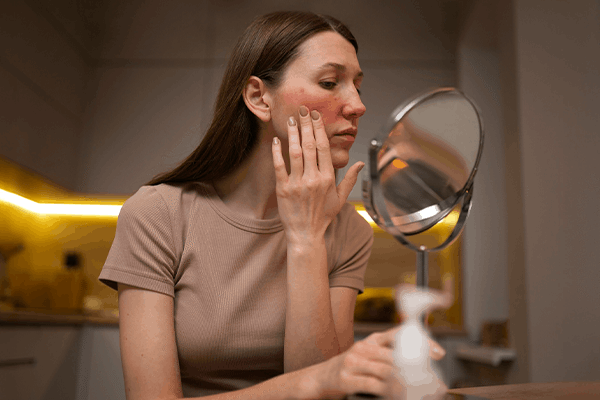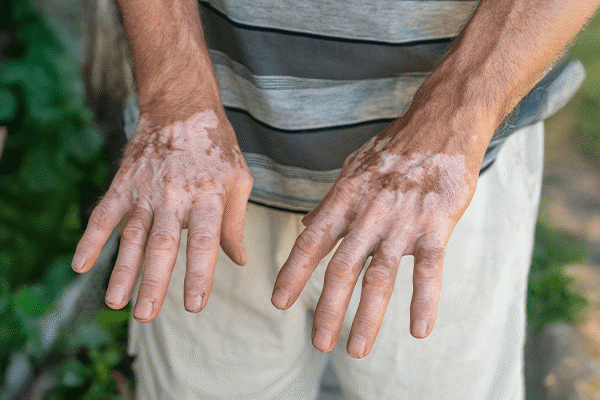
Erythematotelangiectatic rosacea is a chronic dermatological condition characterized by persistent redness and visible blood vessels (telangiectasia) on the face. Flushing and a burning or stinging sensation are also common. Let’s delve into in-depth understanding of ETR rosacea, covering its prevalence, causes, symptoms, diagnosis, associated conditions, potential risks, and treatment options. By the end of this article, you will have a comprehensive understanding of this condition and the various approaches to manage it effectively.
What is Rosacea?
Rosacea is a long-lasting skin disorder causing inflammation, mainly on the face. It is characterized by periods of remission and flare-ups, where symptoms become more pronounced. Rosacea is more common in fair-skinned individuals and often begins after the age of 30.
- Erythematotelangiectatic Rosacea
- Papulopustular Rosacea
- Phymatous Rosacea
- Ocular Rosacea
Also read: Phymatous Rosacea Treatment Options: What Works and What Doesn’t
All About Erythematotelangiectatic Rosacea
It is a common subtype of rosacea, affecting a significant portion of the population. According to the National Rosacea Society, over 16 million Americans are estimated to suffer from rosacea. It primarily affects adults between the ages of 30 and 50, with a higher incidence in individuals with fair skin, particularly those of Celtic or Scandinavian descent. Women are more likely to be diagnosed with erythematotelangiectatic rosacea than men, though men often experience more severe symptoms.
Causes of Erythematotelangiectatic Rosacea
The exact cause of ETR rosacea remains unknown, but several factors are believed to contribute to its development. These include
- Genetics: A family history of rosacea increases the likelihood of developing the condition.
- Immune System: inflammation mainly triggered by intense immune response.
- Environmental Triggers: Sun exposure, extreme temperatures, wind, and humidity can exacerbate symptoms.
- Lifestyle Factors: Stress, alcohol consumption, spicy foods, and hot beverages are known triggers.
- Microorganisms: The presence of Demodex mites on the skin may play a role.
Understanding these factors can help in managing and mitigating the triggers that worsen erythematotelangiectatic rosacea.
4 Signs Someone Could Have Erythematotelangiectatic Rosacea
Erythematotelangiectatic rosacea is primarily characterized by
| Persistent Redness | Central facial redness that resembles a blush or sunburn |
|---|---|
| Visible Blood Vessels | Telangiectasia or visible small blood vessels on the face |
| Flushing | Episodes of facial flushing that can last longer than usual |
| Burning or Stinging Sensation | A frequent sensation of heat or discomfort on the skin |
Other symptoms can include dry, rough skin and swelling. Recognizing these symptoms early can lead to timely diagnosis and management.
Diagnosis
Diagnosing erythematotelangiectatic rosacea typically involves a thorough clinical examination by a dermatologist. The diagnostic process includes:
- Medical History: Reviewing patient history and symptoms.
- Physical Examination: Observing the skin for characteristic signs.
- Rule Out Other Conditions: Excluding other conditions such as acne, lupus, or seborrheic dermatitis which can mimic rosacea symptoms.
Accurate diagnosis is crucial for appropriate treatment planning.
Associated Conditions
Erythematotelangiectatic rosacea can be associated with other medical conditions. A comprehensive understanding of these associations can aid in holistic patient care.
| Associated Condition | Description |
|---|---|
| Ocular Rosacea | Affects the eyes, causing redness, irritation, and swelling of the eyelids. |
| Rhinophyma | Thickening of the skin on the nose, leading to a bulbous appearance, more common in men. |
| Seborrheic Dermatitis | Often coexists with rosacea, causing flaky, white to yellowish scales on oily areas of the skin. |
| Cardiovascular Diseases | Some studies suggest a link between rosacea and an increased risk of cardiovascular diseases. |
Understanding these conditions can help in comprehensive management and improve patient outcomes.
Potential Risks and Complications
If left untreated, erythematotelangiectatic rosacea can lead to several complications, including
- Progression: The condition can worsen over time, leading to more severe symptoms and potential skin thickening.
- Ocular Complications: Untreated ocular rosacea can result in severe eye issues, including vision impairment.
Timely intervention is key to preventing these complications and maintaining quality of life.
Emotional Effects of Erythematotelangiectatic Rosacea
It can significantly impact an individual’s emotional and psychological well-being. The persistent facial redness and visible blood vessels often lead to
- Self-Esteem Issues: Many individuals feel self-conscious about their appearance, leading to decreased self-esteem and confidence.
- Social Anxiety: The fear of judgment or negative reactions from others can cause social withdrawal and avoidance of public situations.
- Depression: Chronic rosacea symptoms can contribute to feelings of sadness and hopelessness, increasing the risk of depression.
- Stress and Anxiety: Constant worry about flare-ups and managing triggers can result in heightened stress and anxiety levels.
Treatment Options
While there is no cure for erythematotelangiectatic rosacea, various treatment options can help manage and reduce symptoms. These include
Topical Treatments
- Brimonidine Gel: Reduces redness by constricting blood vessels.
- Azelaic Acid: Helps reduce inflammation and redness.
- Metronidazole: An antibiotic that decreases inflammation.
Oral Medications
Tetracycline Antibiotics: Such as doxycycline, to reduce inflammation and treat ocular rosacea.
- Isotretinoin: For severe cases, though used less frequently due to potential side effects.
Laser and Light Therapies
- Pulsed Dye Laser (PDL): Targets and reduces visible blood vessels.
- Intense Pulsed Light (IPL): Improves redness and skin texture.
Lifestyle Modifications
- Trigger Avoidance: Identifying and avoiding personal triggers such as certain foods, drinks, and environmental factors.
- Skincare Routine: Using gentle, non-irritating skincare products and sun protection.
Support and Counseling
- Support Groups: Connecting with others experiencing rosacea can provide emotional support.
- Professional Counseling: For those experiencing significant emotional distress due to their condition.
Conclusion
It is a chronic condition that requires a multifaceted approach for effective management. By understanding its prevalence, causes, symptoms, and associated conditions, individuals can seek appropriate treatment and adopt lifestyle changes to mitigate its impact. Continuous research and clinical trials, like those conducted at the Revival Research Institute, aim to improve the understanding and management of erythematotelangiectatic rosacea, offering hope for better outcomes and quality of life for those affected.
For more information and updates on ongoing research, stay connected with the Revival Research Institute.





